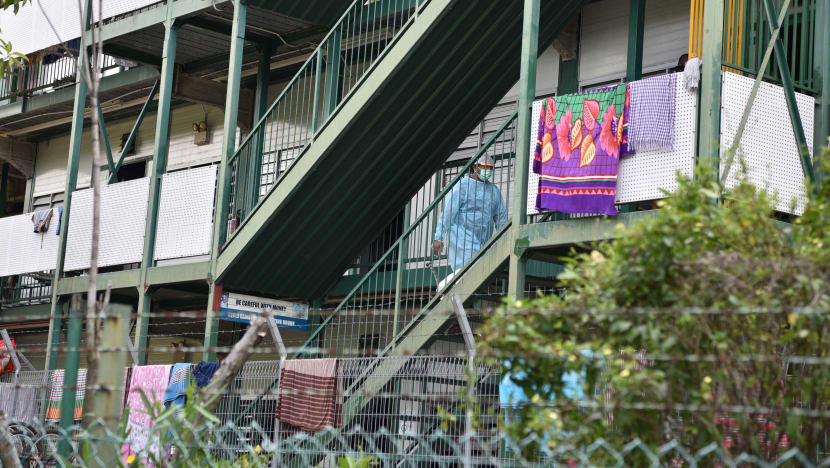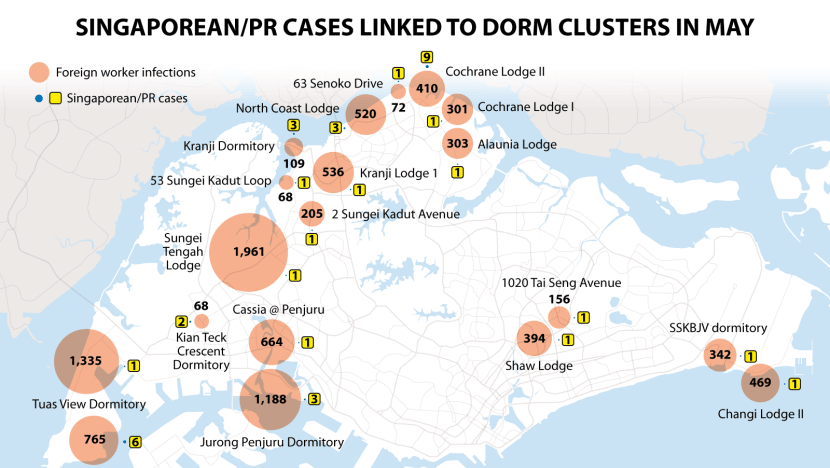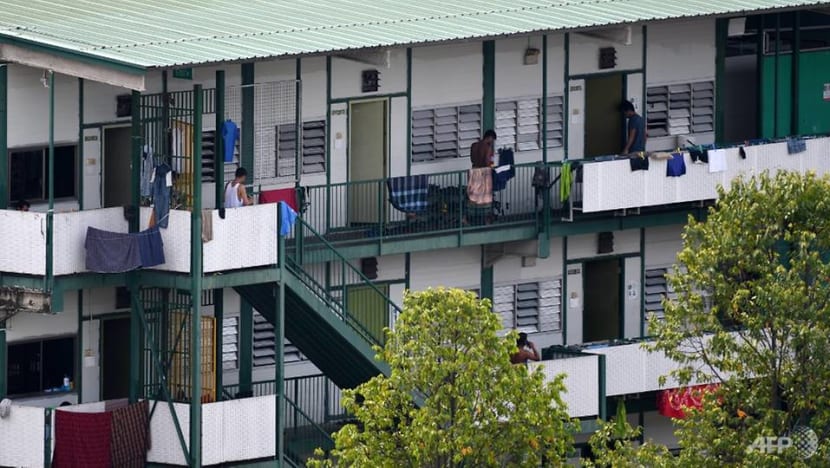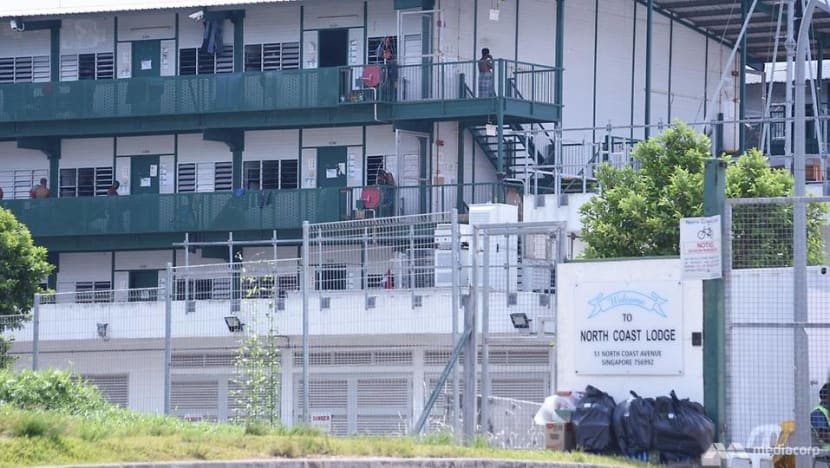COVID-19: More than a third of Singaporean or PR cases in May linked to dormitory clusters
Foreign workers are not allowed to leave their dormitories over concerns of cross infection, but dozens of Singaporean or PR cases in May have been linked to the outbreaks in dormitories.

Cochrane Lodge 2 dormitory was gazetted in April as an isolation area to curb the spread of COVID-19. (Photo: Jeremy Long)
SINGAPORE: More than a third of Singaporean or permanent resident COVID-19 cases in the community in May have been linked to dormitory clusters, an analysis of the Ministry of Health’s (MOH) daily updates has shown.
As of Thursday (May 28), there have been 123 Singaporean or PR community cases in May, of which at least 44 have links to 19 dormitories.
Most of those patients tested positive for COVID-19 after a contact or family member went to work at dormitories and contracted the disease.
At least nine Singaporean or PR cases are linked to Cochrane Lodge II dormitory, including a household of six who became infected after a household contact went to work at the dormitory.
READ: COVID-19: Timeline of infection among Singaporeans and permanent residents
There are more than 30,500 COVID-19 cases among work pass holders living in dormitories.
The number of new community cases daily has dropped steadily since the end of April and Singapore is, as a result, set to exit its "circuit breaker" period on Jun 1.
READ: COVID-19: Circuit breaker might be lifted when community cases fall to zero or single digits over sustained period
READ: Singapore to exit circuit breaker on Jun 1, visiting of parents, places of worship allowed with restrictions
DORMITORIES IN ISOLATION
Several dormitories, including Cochrane Lodge II, were declared isolation areas as the first clusters in dormitories broke out.
On Apr 21, all migrant workers living in dormitories were told to stop work and were not allowed to move in and out of their dormitories until May 4, as more clusters were identified in dormitories. On May 2, this restriction on daily movement was extended until Jun 1.
These measures were put in place to “minimise the risk of further community transmission of COVID-19”, said MOH.
On Apr 21, Manpower Minister Josephine Teo said that this restriction had to be introduced as foreign workers who move in and out of dormitories are “potential channels for cross infections, in both directions”.

COMMUNITY CASES LINKED TO DORMITORIES
MOH figures showed that about a third of Singaporeans or PRs who were confirmed to have the disease in May had either worked in dormitories or were linked to someone who had.
The first two cases of infection between the dormitories and community in May was reported on May 3. There have been 42 more of such cases since then.
These are the dormitories that Singaporean or PR cases are linked to:
Cochrane Lodge II
At least nine community cases are linked to Cochrane Lodge II.

On May 16, a group of three Singaporeans was linked to the dormitory. A 54-year-old man, who worked at the dormitory, tested positive for COVID-19. Two others, who were household contacts of the man, also contracted the disease.
Another Singaporean household has also been linked to the dormitory.
A 58-year-old woman who was not linked to the dormitory at first tested positive for the coronavirus on May 17. She had gone to work at Bishan MRT after the onset of symptoms.
Her family contact, a 30-year-old man, was confirmed to have COVID-19 a day later.
On May 20, four other household contacts linked to the woman tested positive for the virus. MOH investigations showed that one of them, a 62-year-old man, had gone to work at Cochrane Lodge II dormitory.
In total, six members of the same household tested positive for the coronavirus.
CDPL Tuas dormitory
At least six Singaporean cases are linked to CDPL Tuas dormitory.

The first was reported on May 13, after a 48-year-old Singaporean man was deployed for “operations duties” at the dormitory. He tested positive for COVID-19 on May 12 after developing symptoms two days earlier.
On May 21, two more Singaporeans who were contacts of the 48-year-old man tested positive for COVID-19. One of them was Case 30385, a 37-year-old Singaporean man.
Two household contacts of Case 30385 were then confirmed to have the coronavirus on May 23 and May 24.
In a separate case, a 24-year-old Singaporean who worked at the dormitory was confirmed to have COVID-19 on May 16. He is not linked to other cases.
READ: Employers must pay foreign workers isolated in dormitories even if work passes are cancelled: MOM
Kranji Dormitory
At least three Singaporean cases are linked to Kranji Dormitory.
On May 5, a 43-year-old Singaporean woman who was a healthcare volunteer at the dormitory tested positive for COVID-19. Her family member was confirmed to have the coronavirus on the same day.
On May 7, a Singaporean man who is a contact of both cases also tested positive.
Other dormitories
Three Singaporean or PR cases have links to North Coast Lodge, and another three are linked to Jurong Penjuru dormitory, as of Wednesday night.

There have also been community cases linked to Tuas View dormitory, Kian Teck Crescent dormitory, Changi Lodge II, Alaunia Lodge, Sungei Tengah Lodge, 2 Sungei Kadut Avenue, 53 Sungei Kadut Loop, Shaw Lodge, 1020 Tai Seng Avenue, Kranji Lodge I, Cochrane Lodge I, SSKBJ dormitory, and Cassia @ Penjuru.
Some cases are linked to more than one dormitory.
Two quarantine order officers who served orders at various dormitories tested positive on May 6. One of them is Case 20542, a 36-year-old Singaporean man.
A 62-year-old man, who is a contact of Case 20542, was confirmed to have COVID-19 on May 9.
Separately, it was reported on May 16 that a dormitory inspector, a 31-year-old Singaporean man, had contracted the disease. A contact of his, a 29-year-old Singaporean woman, tested positive on May 22.
“VERY MINDFUL OF THE RISKS”
National Development Minister Lawrence Wong said at a press conference last Tuesday that the multi-ministry task force is “very mindful” of the risks that staff members and volunteers face while working in dormitories.
“That's why we have highlighted this before ... we have taken precautions and we have continuously stepped up these precautions for the staff working in these environments, to provide them with the necessary equipment, whether it's PPE, whether it’s masks,” Mr Wong added.
Those who work in dormitories or community care facilities take all the necessary precautions in terms of safe distancing and don’t “expose themselves unnecessarily”, the minister said.
READ: COVID-19: 20,000 migrant workers to be discharged by end-May, but cases from dormitories likely to remain high
If cases are detected, tests are conducted “very quickly” and an active sweep across all the staff in the same area is carried out.
“(This is) so that we are immediately able to detect a case should one emerge, including the close contacts of that worker - their family members, for example – so that immediately we can contain and ring fence any case that emerges.”
He said the task force is watching the situation “very, very closely”, to make sure the precautions are tight and that the safeguards are stringent.
Training will also be stepped up. Healthcare workers in dormitories might have “better training” because of their background, but other roles, such security officers, dormitory managers and dormitory operators, do not have such training.
“We are constantly reaching out to them, engaging them, reminding them of the precautions, providing them with the equipment and doing more tests on a regular basis as well, in order to ensure that these are safe environments for the people who are doing very important and essential work there,” Mr Wong said.
“We want to give the assurance to the staff to the volunteers who are working in this environment that we are doing everything we can to keep them safe,” he added.
Watch the May 19 press conference in full:
BOOKMARK THIS: Our comprehensive coverage of the coronavirus outbreak and its developments
Download our app or subscribe to our Telegram channel for the latest updates on the coronavirus outbreak: https://cna.asia/telegram














